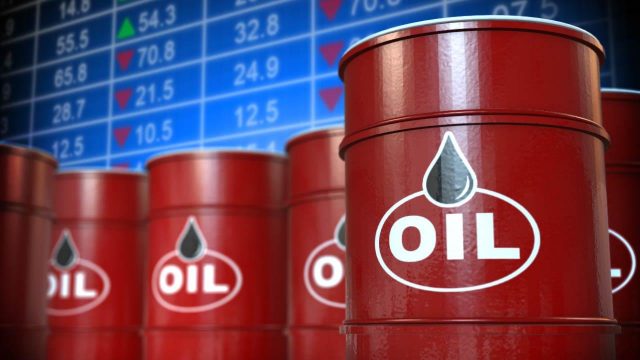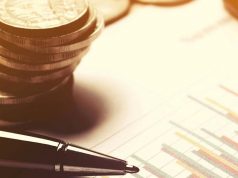… Renaissance Capital and RenCap’s oil & gas team takes a closer look at Nigeria’s upstream and downstream sectors, the effect of high oil prices on Nigeria’s budget.
TUE, 03 MAY, 2022-theGBJournal | At oil prices over $100/bbl, big oil exporters like Nigeria are beneficiaries of the high prices. However, on the fiscal front, the petrol subsidy and falling oil production undermines the gains on the revenue side.
We estimate that the subsidy cost increases by $1.5-2bn for a $10/bbl change in the oil price, and net oil revenue increases by $4-5bn. This implies Nigeria has a ~$3bn net benefit for every $10/bbl change to the oil price (Brent).
The mechanics of the petrol subsidy
Fuel has been subsidised in Nigeria since the 1970s. How does the subsidy work today? Only petrol is regulated. Diesel, kerosene and other fuels are deregulated, implying they are not subsidised. The government sets an ex depot price for petrol (NGN161/l currently) – at which the marketer buys the petrol – and pump price (the retail price, NGN165/l). The national oil company – Nigerian National Petroleum Corporation (NNPC) – buys petrol at international prices and sells it to retailers at the regulated price. When the international price exceeds the regulated price, then the government pays the difference (subsidy).
What is the government’s take from oil revenues?
At the YtD average Brent crude price of c. $100/bl, the Nigerian government takes 45-50% of gross oil sales in the form of taxes and royalties, on our estimates. The remainder goes to the contractor as cost recovery and profits. In 2022, at$100/bbl Brent, we estimate that gross oil revenues to the government (mostly taxes and royalties) will be ~$24.8bn/NGN10.3trn (4.9% of GDP, assuming the current FX rate of NGN415/$1)* and net oil revenues at ~$17bn/NGN7.1trn (3.4% of GDP). Of this, 80% stems from onshore/shallow water oil fields and the remainder from deepwater oil fields.
What percentage of government’s oil proceeds goes to the petrol subsidy?
Assuming $100/bbl oil prices and our forecasted gasoline crack (the difference between one barrel of gasoline and one barrel of crude) of $10/bbl for 2022, we estimate that Nigeria will need to subsidise ~50% of the ex-depot price (~$60/bbl), or ~$8.5bn (1.8% of GDP), assuming ~400kbopd of gasoline consumption and imports. The number is comparable with the provision of NGN4trn (~$9.6bn) for the petrol subsidy in the federal government’s revised FY22 budget. At $100/bl, in 2022, we estimate the petrol subsidy to be ~34% of the government’s gross oil revenue and ~50% of net oil revenues. At the current ~NGN415/$ I&E rate, on an accruals basis, we estimate that the subsidy ranges between 23% and 27% of gross oil revenue for $60-110/bbl Brent.
Impact of a naira devaluation on these numbers?
At NGN500/$ and NGN600/$ and assuming that the pump price does not change, we estimate that the subsidy will cost ~$10bn and ~$11.3b,n respectively (at $100/bbl Brent) or ~$1.3bn for a NGN100 movement of the naira relative to the dollar To estimate the petrol subsidy, we assumed Nigeria consumes 23bn litres of petrol a year (400kbpd), which is taken from the most recent 12-month consumption, according to the NNPC, which was the year to August 2021.
Nigeria is a federation, implying it operates at three levels of government: federal, state and local government. The NNPC remits the government’s share of proceeds from crude oil sales into the federation account at the central bank. This is shared monthly to the three levels of government, less the petrol subsidy cost. This is important because the amount remitted can be undermined by: 1) rising subsidy payments; 2) declining oil production; and 3) high oil production costs. NNPC reportedly only remitted 20% of its projected contribution to the federal account in 2021 and failed to remit anything in January.
What is the effect of the petrol subsidy on the budget?
We estimate that the cost of the subsidy increases by $1.5-2bn for a $10/bbl movement in the oil price. However, net oil revenue increases by $4-5bn, implying that all in all, Nigeria has a ~$3bn net benefit for every $10/bbl change to the oil price, by our estimate, without factoring in other externalities, including VAT receipts that may grow as a result of higher GDP growth resulting from a higher oil price.
The petrol subsidy falls away when oil prices are below $45-50/bbl, by our estimate. Below this price, the government’s take of oil proceeds is fully remitted and not undermined by petrol subsidy deductions. The reinstatement of the petrol subsidy in January partly explains the revision of the FY22 budget targets and assumptions, including the widening of the deficit target.
In April, Nigeria’s federal government revised its budget deficit target to 4.0% of GDP in FY22, vs its initial target of 3.4% on the back of new developments including the Russia Ukraine situation. President Muhammadu Buhari wrote to parliament and called for an amendment to the Federal Government of Nigeria’s (FGN) budget, to account for the wider deficit and increase in borrowing. According to Buhari, the new developments include: 1) the reinstatement of the petrol subsidy; 2) the sharp increase in oil prices; and 3) significantly lower crude production, mainly due to production shut-ins because of massive crude theft between the production platforms and terminals.
The president also proposed adjusting the FGN’s budget assumptions as follows: 1) increase the oil price benchmark to $73/bbl, from $62/bbl previously; 2) lower projected crude production to 1.60mbd, from 1.88mbd previously; and 3) increase the estimated provision for the petrol subsidy for 2022, to NGN4trn, from NGN443bn ($9.6bn) previously, when it was assumed the subsidy would be removed in July. This is also an increase when compared to the NGN3trn that the NNPC called for in January, soon after it was announced that the subsidy would remain in place. Due to the adjustments, the federation account revenue pool for the three tiers of government (FGN, states and local government) is projected to fall by NGN2.4trn (1.1% of GDP, by our estimate), and the FGN’s share by NGN1.2trn (0.6% of GDP).
Nigeria’s fiscus will not benefit from high oil prices in FY22
Nigeria’s gain from high oil prices is being undermined by 1) the swelling of the petrol subsidy as the oil price increases; and 2) a fall in oil production due to theft and underinvestment. Figure 5 shows that as the oil price increases, the FGN’s budget deficit has narrowed, albeit in small increments. An 80% increase in the oil price, from $41/bbl to $72/bbl, reduced the budget deficit by c.1 ppt only. 2021 was an outlier. We attribute the widening of the deficit in 2021, despite the high oil price, to the fall in oil production that countered the price effect.
Our ‘trendline’ suggests that if we assume an average oil price of $100/bl for 2022 and production at pre-2021 levels, then the FGN’s budget deficit would come in at c. 3.5% of GDP. We are forecasting a deficit of 4.7%.
Estimating Nigeria’s receipts from oil and gas
Nigeria’s hydrocarbon fiscal terms are based on terrains and depth. There is a 20% royalty rate for onshore production, and shallow water from high teens to 20% (marginal fields have a reduced royalty rate but their production contribution is small). The 2019 Deep Offshore and Inland Basin PSC (Amendment) Act, introduced a 10% base royalty to deepwater fields plus an oil price royalty element of 4% for oil prices between $60-100/bbl and 8% for prices over >$100/bbl. Petroleum Profits Tax (PPT) is 85% for the onshore and shallow offshore terrains and 50% for deepwater. The Petroleum Industry Act has improved fiscal terms for oil and gas companies, although none of the companies have converted to the new fiscal terms since the bill was signed into law in August 2021. Tax depreciation is a five-year straight line.
We expect Nigeria’s 2022 production to be within the 1.5-1.7mmbopd range (1.6mmbopd midpoint), comprising 1.1mmbopd onshore and shallow water production and ~500kbopd for deepwater. On an accruals basis, we estimate that at $100/bbl Brent, Nigeria will make ~$25-30bn in taxes and royalties in 2022. The table below outlines our assumptions and government take (accruals basis) estimates at different oil prices.
In Nigeria, companies are allowed to pay Petroleum Profits Tax on a monthly basis, based on financial projections of the year, or in May the following year. Royalties are payable on a monthly basis based on actual production (but after reconciliation losses) at a price set by the Nigeria Upstream Petroleum Regulatory Commission (NUPRC). We expect actual PPT receipts in 2022 to be lower than our accruals basis forecasts, as most/some of the tax payments will reflect 2021 oil prices (~$70/bbl) and the full oil price upside is to be reflected in 2023.
We forecast Nigeria to receive ~$21bn in 2022 (4.6% of GDP) from PPT and royalties, compared to our ~$28bn accruals estimate. Taxes and royalties are only one part of the equation. Nigeria also receives profit from O&G sales (mostly NNPC activities), which we estimate to push 2022 gross oil revenue to $24.8bn (4.9% of GDP), compared to $12.1bn (2.7% of GDP). There are, however, material deductions related to the oil and gas sector, including federally funded upstream capex, contributions to the 13% derivation fund for the Niger Delta oil-producing States and other items. Considering these items, we expect Nigeria’s net oil revenue to be $17bn in 2022 (3.4% of GDP), at $100/bbl Brent, up from ~$7bn in 2021 (1.7% of GDP).
Nigeria’s subsidy problem
Fuel has been subsidised in Nigeria since the 1970s, when subsidies were introduced in response to the oil price shock of 1973. Initially the government sold it below cost. This was eventually institutionalised in 1977 under the Price Control Act, which made it illegal to sell fuel above the regulated price. Only gasoline (premium motor spirit or petrol) is regulated and subsidised, while diesel, kerosene and other fuels are deregulated and not subsidised. The government sets an ex-depot price for petrol – this is the price at which the marketer buys the petrol from the government – and pump price (the retail price).
Since 2018 NNPC is the sole importer of gasoline in Nigeria, amid increasing subsidy receivables from the government to major and independent marketers. NNPC buys petrol at international prices and sells it to marketers at the ex-depot regulated price. When the international price exceeds the regulated price, then the government pays a subsidy.
In Nigeria, the regulated gasoline pump price is N165/litre and the ex-depot price is N161/litre. Assuming $100/bbl oil prices and our forecasted gasoline crack of $10/bbl for 2022, we estimate that Nigeria will need to subsidise ~50% of the ex-depot price (~$60/bbl), or ~$8.5bn (1.8% of GDP), assuming ~400kbopd of gasoline consumption and imports. The number is comparable with the NGN4trn (~$9.6bn, 1.9% of GDP) subsidy costs in the proposed revised budget.
High oil prices – good or bad?
Stacking everything together, although we estimate that the cost of the subsidy increases by $1.5-2bn for a $10/bbl movement in the oil price, we estimate net oil revenue to increase by $4-5bn. All in all, we estimate that Nigeria has a ~$3bn net benefit for every $10/bbl change to the oil price, without factoring in other externalities, including VAT receipts, etc.
Twitter-@theGBJournal|Facebook-The Government and Business Journal|email: gbj@govbusinessjournal.ng|govandbusinessj@gmail.com










